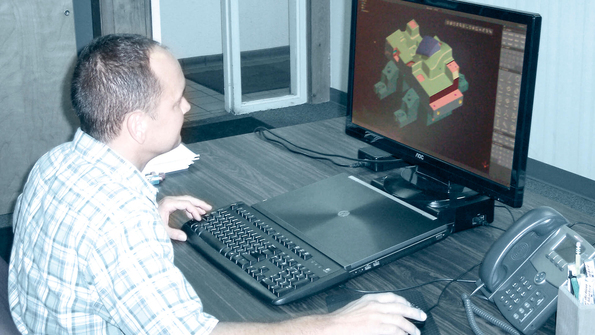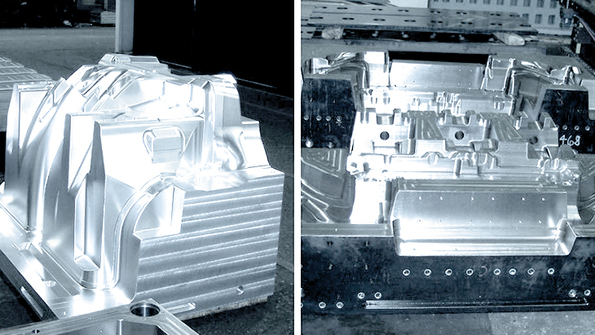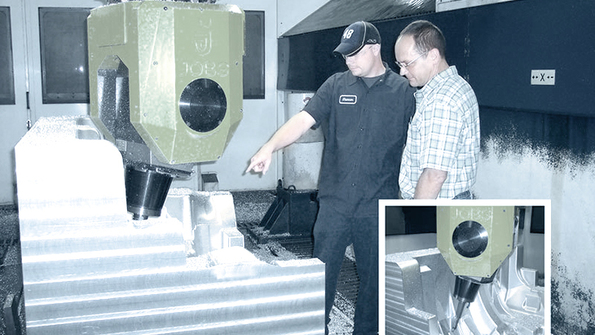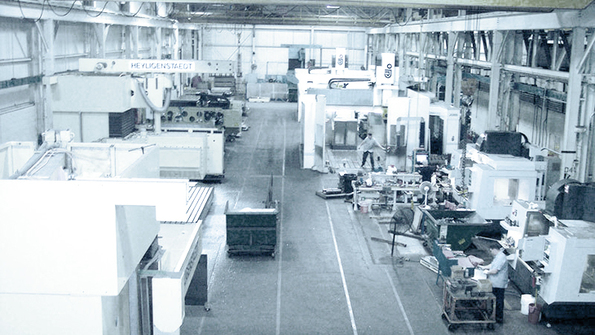Century Tool and Tebis combine for weight and speed
Tebis at Century Tool & Gage
Century Tool has won success processing large workpieces; now, with help from software provider Tebis, they are doing it faster and more efficiently than ever.
Company
Century Tool & Gage
Location
Fenton, Michigan, United States
Focus
CNC milling, turning and grinding
Benefits:
- Century Tool and Tebis combine for weight and speed
- Roughing was 30 % faster with Tebis than with the software package they have been using
- Surface finish improvements
Sector
Mold manufacturing
Published
2015

Interviewee: Mickey Guckian, CAD/CAM Manager
Programming 3+2 milling is substantially easier in Tebis than the other softwares we have seen. The guys here claim they would never program with the other software again if they do not have to.

Century Tool & Gage (Fenton, MI) knows big workpieces. The company, which has made a name for itself building compression molds and secondary tooling for the automotive, heavy truck, aerospace and personal watercraft industries, includes tooling for large exterior body panels like roofs, hoods and deck lids among its portfolio of products. “We have the ability to handle blocks of up to 60 tons and machine block sizes up to 100-in. wide by 300-in. long,” notes Mickey Guckian, CAD/CAM manager at Century.
Early on, Century realized that success in its chosen field demanded first-rate technology, like Jobs high speed five-axis machining centers with bed sizes ranging from 80 x 200-in. to 140 x 220-in., Jo'Mach vertical mills with five-axis heads for both roughing and high speed finishing, and Heyligenstaedt vertical mills capable of handling up to 20 tons of weight on the bed plate, among other top performers. They used the same philosophy when picking a CAM system, and chose Tebis.
“Tebis is considered to be the industry's best software for 5-axis machining,” says Kevin Cummings, engineering manager at Century. “It combines quality and flexibility, and gives our customers the highest degree of accuracy and speed.”
“Specifically, we do a lot of large components such as truck molds, etc.,” reiterates Mickey Guckian, CAD/CAM manager for Century, “and one of the things that Tebis does really well is larger jobs.”
The fastest tool for big jobs
“Other CAD software packages often struggle with big parts because big parts generally entail a large amount of data, and large amounts of data will slow down the software. With Tebis, though, the algorithms, plus the design of the software, enable it to handle massive amounts of data very quickly. This has been a big factor in our success with the software,” Guckian notes.
In addition, Century also does a lot of “head work,” or 3+2 axis tip angle work. In machining large parts, Guckian explains, it is often necessary to tip the machine head in order to adjust the machining angle. “Any time you have to change the angle or vector of the tool you are adding a lot of complexity which, again, can slow down your software, but Tebis can handle this.”
“Ours isn’t the only system that can handle 3+2 axis tip angle work,” admits John Kowalczyk, a Tebis sales manager who has worked closely with Century through the years, “but we bring something new to the party. You can click on the machine head or the tool and simulate its operation, make adjustments on the fly if need be, and then send this amended or edited program back to the machine.”
Simple machining of complex geometries
Tebis simulation and analysis tools enable users to identify and avoid possible collisions between component and tool geometry, check tool lengths before NC program calculation, and interactively define the optimum tilt direction. In addition, the system’s material removal simulation lets users realistically assess surface qualities.

These tools are particularly useful when Century employs full 5-axis simultaneous milling. Before they calculate an NC program they can perform a detailed analysis of the tilt directions for the tool, also taking head geometry and machine kinematics into account. Collision avoidance calculations include the holder components defined in the Tebis tool library, and the Tebis simulator checks all machine components and limit switches.
Guckian adds that Tebis permits simple and intuitive operation, even during 5-axis simultaneous machining, thanks to its standard onboard operating strategies. In addition, this facilitates the machining of complex geometries without multiple setups.
“Automotive is our largest niche but we do take on aerospace fuselage parts which require full five-axis machining,” says Guckian. He states flatly that “We would never have been able to do these parts if not for the capabilities of Tebis.”
John Kowalczyk of Tebis notes another aspect of his company’s 5-axis simultaneous machining capability. “With many other 5-axis CAM solutions the machine’s movement can be choppy. With Tebis these movements can be done very smoothly, leading to good surface finishes, a vital consideration in aerospace.”
Boosting quality and efficiency
Speed, is also a vital consideration in all areas of production machining and not just aerospace. “The drive to become more efficient and have better quality are ongoing imperatives with Century, as with other progressive manufacturers,” notes John Kowalczyk.
“Before they were even a customer of Tebis we were able to come in and do a benchmark study of their roughing operations,” he continues. “The study showed that roughing was 30% faster with Tebis than with the software package they were then using. That obviously would be a terrific savings, but in addition to that the resulting surface quality was better, so moving to Tebis was pretty much a no-brainer.”
Guckian adds “We’ve machined blocks heavier than 100,000 pounds, and some of the blocks we were roughing would take five to six days. With Tebis that work took three to four days. Approximately 95 percent of that is 3+2 axis tip angle work, and the ability of Tebis to handle this work so quickly and accurately, and facilitate our ability to do things like rotating the tool axis to get a shorter tool, which can affect speed, quality, and process reliability, have had a big effect on these big parts.”

These speed improvements haven’t been limited to 3+2 axis work. “With one of the early five-axis simultaneous machining projects for an aerospace part that we cooperated on,” says Kowalczyk, “they were able to complete the project in five days as opposed to the 14 days required with their previous, traditional strategies.
Benching, too, has been speeded. “The overall time required to bench the molds has been reduced very substantially,” observes Guckian. “In addition, I’ve mentioned the surface finish improvements that Century has been able to gain through its use of Tebis. This is highly significant for us since probably 60 percent of our molds are Class A surfaces, which are visible parts on the vehicles -- hoods, fenders, trunks, roofs, etc. Every little detail and body line has to meet the customer’s demanding standards.”
Speedier detailing of smaller workpieces

And the speed improvements have not all been limited to large workpieces. “The Tebis 2.5D Drilling and Milling module has been particularly helpful with our smaller workpieces,” notes Mickey Guckian. This module allows users to edit holes, pockets, planar surfaces and ruled geometries, despite their differences. Users can call up and manage relevant tools in the Tebis library and individually assign them to different machining operations and machines. They can create templates embodying best practices and optimal machining parameters, thus speeding future work as well as the job at hand.
Guckian reports that this module has allowed them to get small mold details finished 75 percent faster than before. Programming, too, is a fraction of what it used to be.
Integrated CAD for quick corrections
Solving surface data inconsistencies is also increased. That’s a big claim to make, but Tebis’ Kowalczyk insists he can back it up. “We won’t sell our CAM software without some basic CAD so that users have access to essential CAD and editor functions. This allows them to analyze data imported from other systems, correct glitches, and generally improve the quality of the work.
“What happens when you introduce a design into your CAM system?” he continues. “What about surface flaws and self-intersecting surface, what about run-off, missing surfaces and irregularities? You see, there are often some glitches or blank spots, but with the analysis tools made possible by the CAD functionality you have many things you can use to correct them.”
Software that keeps getting better
And the Tebis features and innovations aren’t static, but grow over the years. “With other software the updates weren’t worth the maintenance fees,” recalls Guckian, “but with Tebis the updates were all good. For instance, the full machine simulation module didn’t exist when we first got the software, but our package has been updated with functionality like that, functionality that’s been a great help to us. Plus, they work with our day-to-day users, asking us what enhancement we would like to see in a future version.”
Summing up, “The complete shopfloor control with the CAD/CAM functions that we get with Tebis has allowed us to program and make toolpaths faster,” says Guckian. “Programming 3+2 milling is substantially easier in Tebis than the other softwares we have seen. The guys here claim they would never program with the other software again if they do not have to.”


